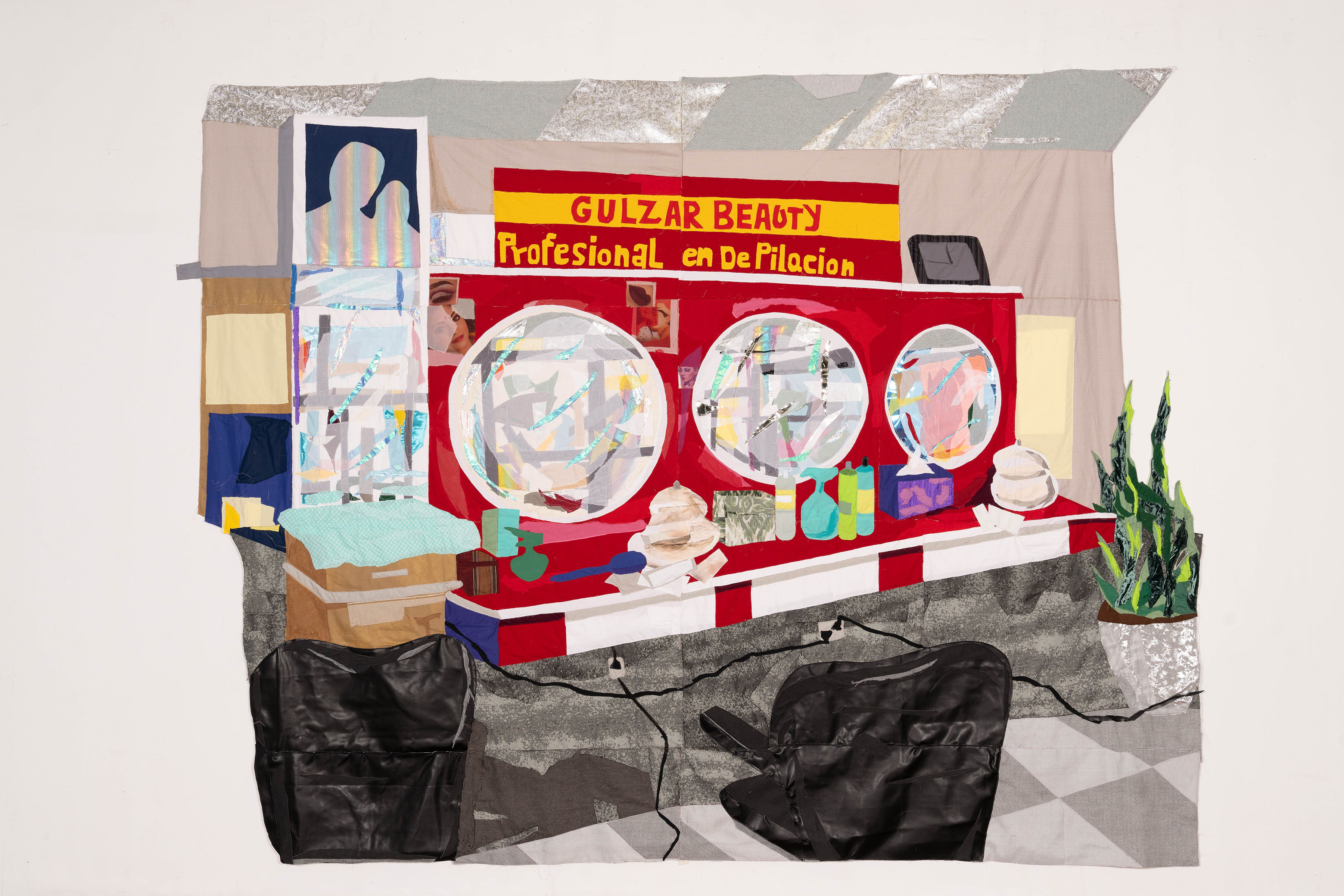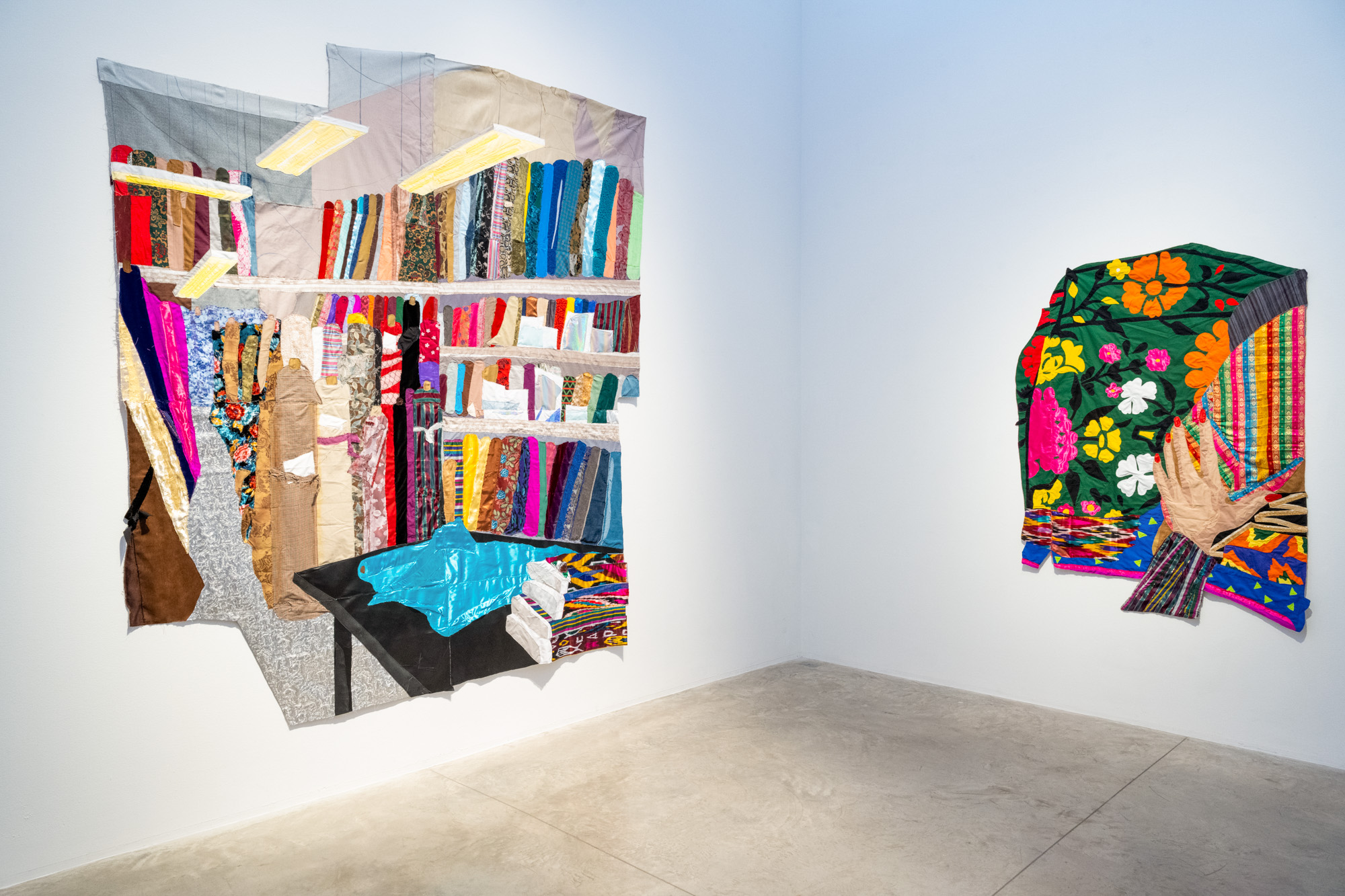Shows
Hangama Amiri’s “Wandering Amidst the Colors”


For those of us who immigrate out of our home countries as children, it’s difficult and potentially futile to conceptualize home as a specific place. In lieu of a fixed physical location, home is often recommended to be situated in people—home as loved ones and family. But can home be a sensibility? An aesthetic feeling? Afghan-Canadian artist Hangama Amiri’s exhibition “Wandering Amidst the Colors” suggested it can. Having left her birthplace, Kabul, as a child due to the Taliban and grown up subsequently in Iran, Pakistan, and Tajikistan, Amiri often centers her practice on the effects of geopolitical conflicts and gender norms, evoking a diasporic visuality marked not by loss or precarity but by lush colors and layered sociality. For her first solo show in New York at albertz benda, Amiri employed various fabrics and hand-painted elements to depict Central Asian diasporic communities—encapsulated in supermarkets, beauty salons, restaurants—in Flushing and Jackson Heights neighborhoods in Queens.

In A.K. Fabric Shop (2021), Amiri recreated the interior of an Afghan-owned shop in Chelsea that she began to buy fabrics and textiles from in 2019 while working on her MFA at Yale. Textiles serve as a potent, haptic connection to her childhood: Amiri grew up living close to bazaars in Afghanistan, Pakistan, and Tajikistan that abounded with colorful textiles. In A.K. Fabric Shop, the form and content collapse: a fabric store packed with lines of fabric rolls is depicted using the actual fabric—chiffon, silk, satin, muslin, cotton, lace, suede, denim—sourced from the titular store. The use of slight illusionistic depth gives the viewer a sense of peering into the store, and the work’s edges resemble organically cut fabric, circumventing the rectangular framing and linear boundedness of traditional canvas. On reworking the notion of the frame, Amiri says, “I choose to work with fabric because it helped me resolve a question I repeatedly asked myself within my studio practice: the issue of the frame . . . When I work from memory, those memories never have a perfect edge. I wanted to rip apart the frame because I am interested in the imperfections and fragmented edges of my memories.”
As such, Amiri’s choice of medium goes beyond questions of hierarchy between textiles and traditional mediums such as painting (and accompanying issues of gendered labor) to ask what the medium of textiles does, not just signifies. For Amiri, textile as a medium is able to evoke the fragmented nature and mutability of memory and place. In her works, textile is not merely an abstract tool to contest the canonical enshrinement of painting and sculpture; while indeed functioning in this symbolic mode, textile also operates as a medium in its own right, fully fleshed out and luxuriating in its materiality.
In the room adjacent to the one with A.K. Fabric Shop, a series of foods rendered in various fabrics and acrylic paint offer another entry point into sensorial notions of diasporic sensibility. Illustrating kebab with rice, Afghan baked goods, and grapes paired with palow against rich patterns, these textile works are what Amiri calls a “reformulation of the traditional still life.” These works depart from traditional Western still life not just in their different cultural context and medium but also in their vibrant, playful presentation. Some of them feature disembodied fingers with bright red nail polish pointing at the food. Rather than straining to plumb their own profundity—no skulls or memento mori here to remind you of your inevitable mortality—these works instead invite viewers to relish in the emotional succor of familiar foods that umbilically tie them to their roots. In Amiri’s works, art is a way to savor the world, a calling her works take seriously and consummate with thoughtful attention to the visual vocabulary of belonging.
Hangama Amiri’s “Wandering Amidst the Colors” is on view at albertz benda, New York, until May 1, 2021.







